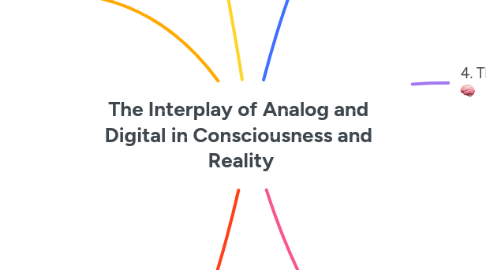
1. 1. Introduction
1.1. Modern physics challenges the idea of a fixed reality.
1.2. Quantum mechanics reveals the role of perception and measurement.
1.3. Analog and digital concepts reflect the structure of reality and consciousness.
1.4. The interplay bridges the infinite (wave) and the finite (particle).
2. 3. Digital: The Finite Particle ⚛️
2.1. Observation collapses infinite possibilities into a specific state.
2.2. Digital characteristics:
2.2.1. Discrete, structured, and defined.
2.2.2. Like pixels in an image or binary in computing.
2.3. Quantum mechanics parallel:
2.3.1. Wavefunction collapse upon measurement.
2.4. Consciousness as the measuring device:
2.4.1. Converts the infinite into the definite.
3. 5. Examples in Science and Philosophy 🔬🎭
3.1. Quantum Measurement Problem
3.1.1. Before observation: a quantum particle exists in multiple states (analog).
3.1.2. Upon measurement: collapses into a single state (digital).
3.2. Neural Processing
3.2.1. Sensory data is continuous (analog).
3.2.2. Brain categorizes perceptions into distinct experiences (digital).
3.3. Music and Art
3.3.1. Violin sound flows smoothly (analog).
3.3.2. Digital sampling converts it into discrete values (digital).
3.4. Life Choices
3.4.1. Every moment holds infinite possibilities (analog).
3.4.2. Each conscious decision creates a fixed reality (digital).
4. 2. Analog: The Infinite Wave 🌊
4.1. Reality, when unobserved, exists as a wave of possibilities.
4.2. Analog characteristics:
4.2.1. Continuous, fluid, and infinite.
4.2.2. No discrete separation—like sound waves blending.

